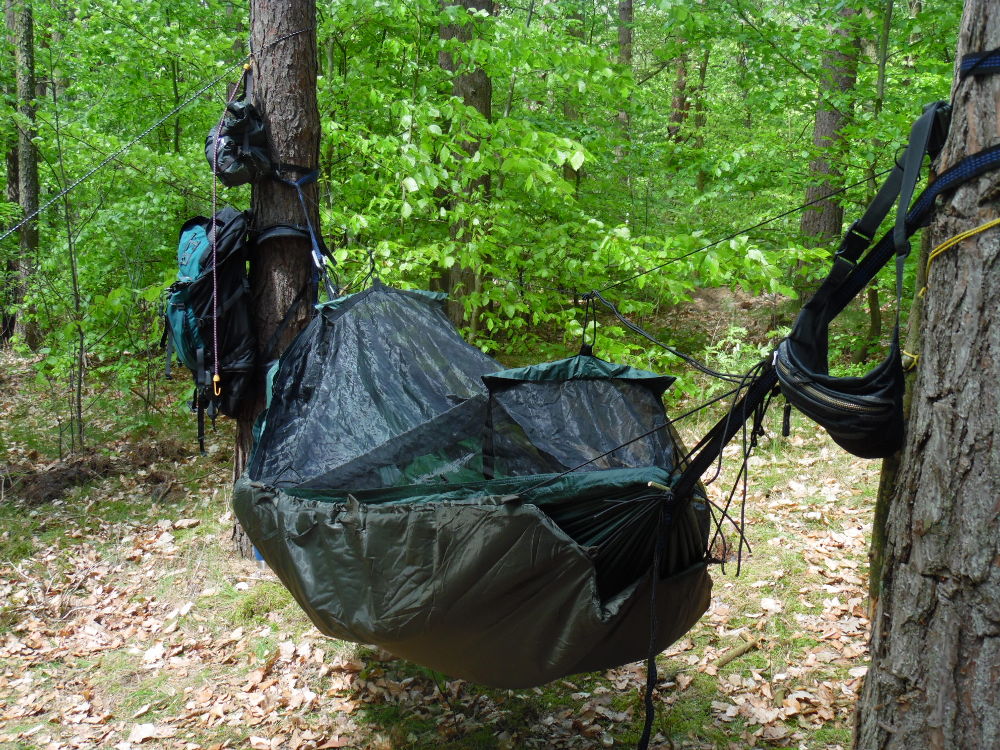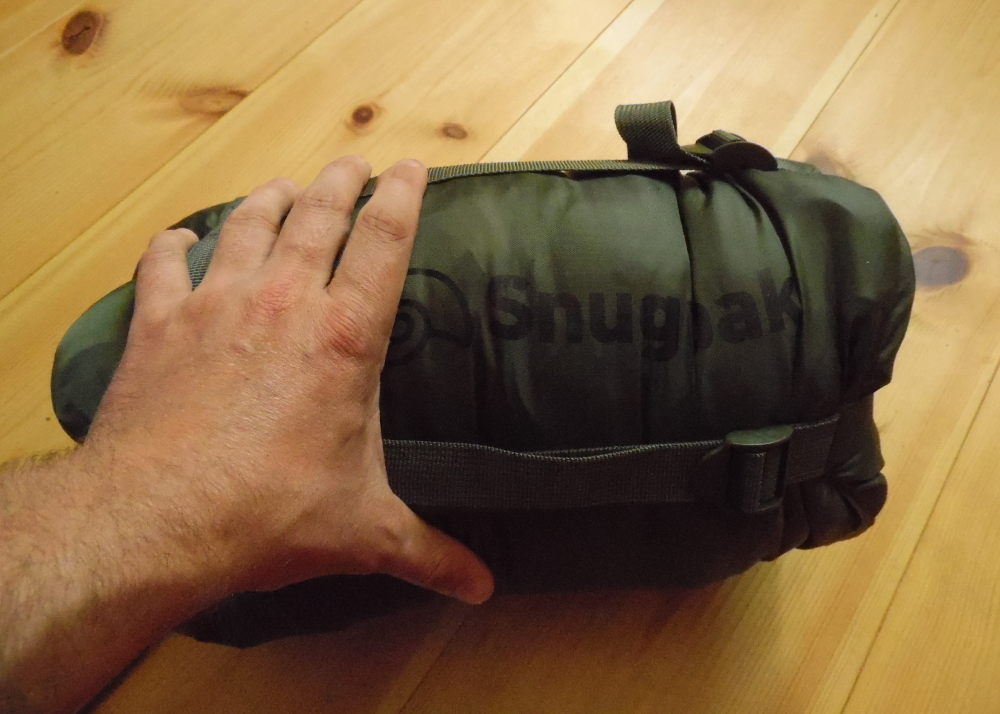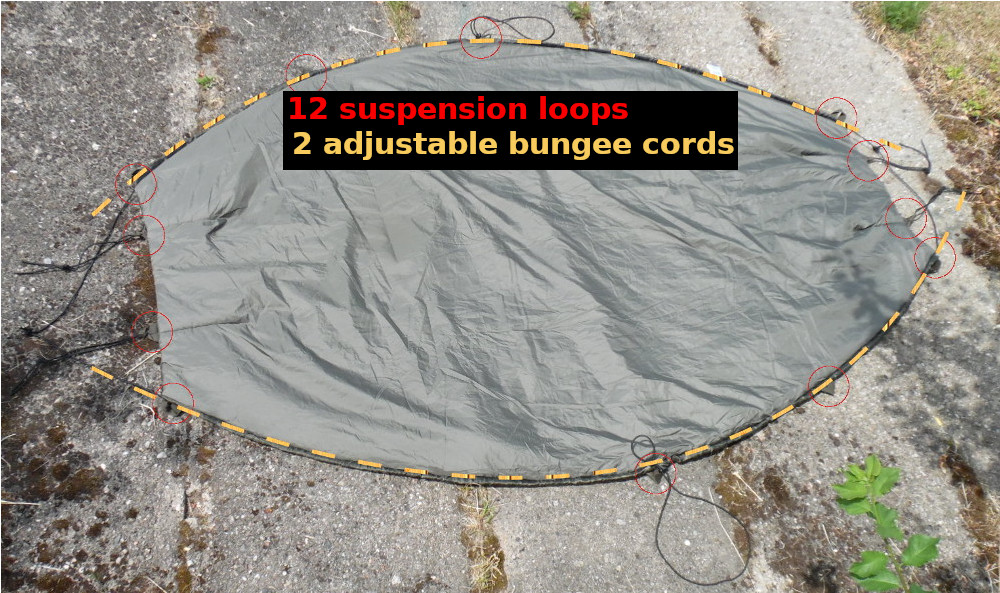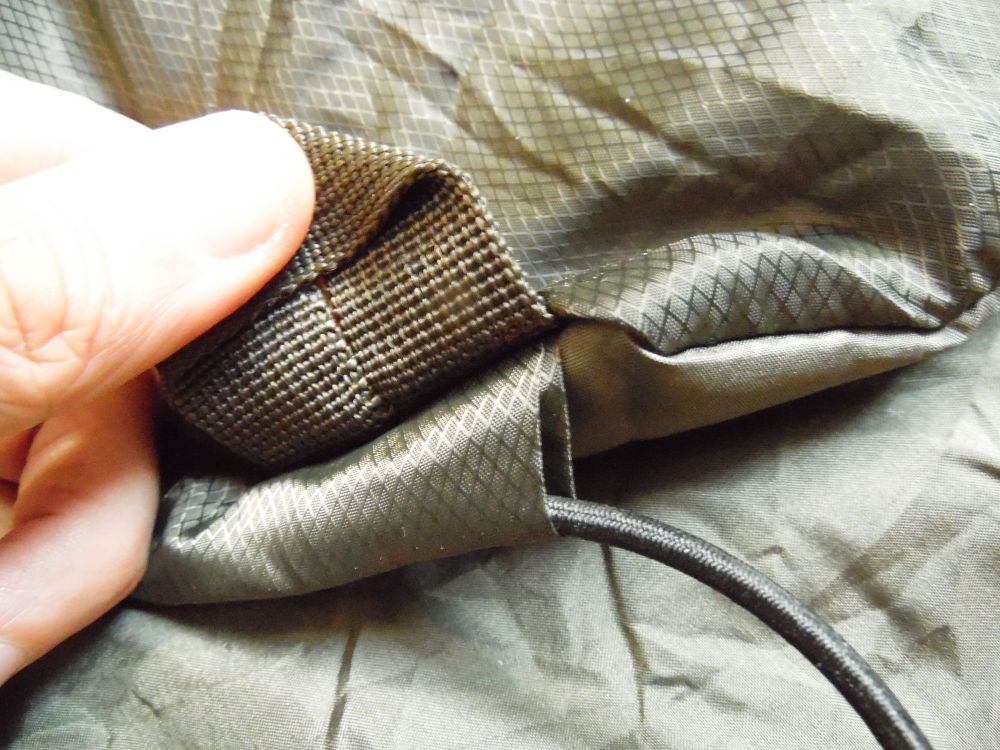This review of the Snugpak Underquilt describes the pros and cons I’ve noticed during my many nights with this hammock underquilt, and what additional material I recommend with this underquilt. An underquilt under the hammock protects against the cold when camping in the hammock.
But before we get started with the review of the Snugpak Underquilt, here’s some basic information about an Underquilt or Underblanket and why it’s so handy for hammock camping.
What is the function of an underquilt for a hammock?
Hammocks are mainly used in tropical or subtropical climates. In these regions, they provide pleasant coolness while sleeping and are super comfortable. But here in Germany the climate is too cool for a night in the hammock without additional protection against the cold. An underquilt under the hammock warms from below. With a good underquilt and a sleeping bag, you can sleep in the hammock here even at sub zero degrees in winter.
The hammock problem: Freezing due to cold from below
Whoever wants to use hammocks away from hot days in midsummer knows the problem: Despite a warm blanket or sleeping bag, you quickly freeze in the hammock. Responsible for this is the windchill effect (wind chill). Wind blows under the hammock and the downwardly released body heat is literally blown away. This causes the shoulders, back and buttocks to feel cold. In these regions, the clothing and sleeping bag are compressed between the body and the hammock, which is why no warming air cushion can form. A blanket or sleeping bag cannot prevent freezing because there is no effective downward insulation. Besides underquilts or underblankets, sleeping pads can also be used in the hammock.
How does an underquilt work as insulation under the hammock?
An underquilt is designed to prevent freezing in the hammock. In some cases, an underquilt is also called an underblanket. The Underquilt hangs like a second hammock under the actual hammock. However, it is only meant to protect against the cold. Gear cannot be stored in it. There are separate Gear Hammocks for this purpose. Underquilts should only carry a little more than their own weight.

Since the underquilt hangs under the hammock, its insulation is not compressed by body weight. Therefore, a warming air cushion can build up between the hammock and the underquilt. Due to the windproof outer fabric of the Underquilt, the insulating air cushion cannot be blown away by the wind. Thus, an underquilt prevents freezing in the hammock.
Review of the Snugpak Underquilt / Underblanket
The Underquilt / Underblanket from Snugpak* is an underquilt for (almost) all hammocks. It can most easily be attached to gathered-end hammocks like the DD Frontline Hammock. With side elastics, the Underquilt is adjusted to fit around the hammock like a protective shell.
- Weight: 1450g (including compression sack)
- Size: 213 x 147cm
- Insulation material: synthetic Travelsoft polyester filling
- Color: olive (pack sack and underquilt)
- Material: water-repellent, breathable and partly antibacterial polyester fabric (MicroDiamond Ripstop)
- Scope of delivery: compression stuff sack, underquilt, elastic straps, unfortunately no carabines are included (!)

Advantages of the Snugpak Underquilt
During the Hammock Underquilt test I noticed these three advantages of the Snugpak Underquilt, which were made better in comparison with simple underquilts: lateral adjustment possibilities / can also be used as a blanket and it has several hanging loops. As a comparison for this underquilt test, I’m using the underquilt from OneTigris* – my second underquilt. Both are quite different in their construction and therefore have their own their pros and cons. In this review of the Snugpak Underquilt I want to emphasize the following two advantages:
Lateral adjustments on the Snugpak Underquilt
The important thing with the Underquilt is perfect adjustment. A poorly hung underquilt cannot protect you from the cold in the hammock, despite its good technical properties. It should not hang too tightly, but also not too loosely under the hammock. With the optimal adjustment, it lies only very lightly against the hammock. With the two side adjustments, this can be done while lying in the hammock. With the OneTigris Underquilt, this requires leaving the hammock, which is awkward and takes a long time.

This is how the Underquilt looks when spread out: it has 12 loops and 2 adjustable elastic straps.
Structure of the Snugpak Underquilt: 12 loops and 2 adjustable elastic bands make it easy to adjust the underquilt without leaving the hammock.
The adjustment of the elastic band pulls is placed in the middle. This makes it possible to adjust them from lying in the hammock. This is problematic for hammocks with mosquito nets: the mosquito net should have a zipper on both sides, otherwise only one adjustment option can be reached from inside the hammock.
Dual-Use from Snugpak Underquilt: Thermal protection for the hammock or usable as a blanket
The base of the Snugpak Underquilt is flat. Like a blanket, the edges of which have been rounded. In contrast, the OneTigris underquilt is like a piece cut from an orange peel. It cannot be spread out flat. The Snugpak underquilt, on the other hand, can be used as a blanket in a hammock or when sleeping on the floor with a sleeping pad.
Disadvantages of the Snugpak-Underquilt
During this test of the Snugpak Underquilt, I also noticed a few negative things. It concerns the weight, its size and possible improvements for large tree spacing or long hammocks.
Weight of the Underquilt
The Snugpak Underquilt is quite heavy at 1450g compared to the OneTigris Winter Underquilt (1150g). However, Snugpak does not specify a recommended temperature range. However, the Snugpak Underquilt warms much better than the OneTigris one, which is advertised as a supposed 3-season underquilt with 5°C to 20°C. The fact is that many use the Snugpak underquilt in the winter as well. I would not attempt this with the OneTigris Underquilt.
Suspension under long hammocks
The Underquilt from Snugpak is attached according to the instructions on the one hand to the hammock itself and on the trees. For optimal adaptation to the hammock, it is attached with elastics to the same suspension points as the hammock. So, as a rule, to the same trees where the hammock hangs. The problem is the distance between these suspension points.
My old Amazonas Mosquito-Traveller hammock has a length of 3,35m from eyelet to eyelet with which I hung between two trees with almost 7m distance. The rubber bands are too small for large tree spacing and with long hammocks they are stretched very tight. This will cause the rubber bands to wear out quickly. Here, the suspension does not work in the pattern Snugpak described in the assembly instructions from the Underquilt. It takes some creativity here.

Ideally it fits my Frontline hammock from DD Hammocks, whose eyelets have a distance of only about 2.7m. The DD-Frontline also has 2 zippers on both sides for a good adjustment from the Snugpak Underquilt, while the Mosquito-Traveller has a zipper only on one side.
Additional material required for suspension under long hammocks or large tree spacing
In the Underquilt hammock test with long hammocks, there were problems. The Snugpak Underquilt works optimally with Gathered End hammocks, which have a carabiner for suspension (e.g. for tree straps) right at the ends. However, if the hammocks have equal length attachment ropes to the tree instead of a loop with a carabiner, then it takes additional material for the suspension.
For this reason, I always carry a couple of lightweight aluminum carabiners* and high-strength 3mm Dyneema cord*. With these I can also attach the hammock if necessary, build a ridgeline or simply attach gear to the backpack. Extra carabiners and extra cord are always worth their weight in gold when camping!
Testing the Underquilt insulation: how warm does it keep?
The Snugpak underquilt provides excellent insulation. In the hot summer, I found it to be too warm when tested. However, it is ideal for spring, fall and winter. For summer, a lightweight summer underquilt from OneTigris* weighing only 840g is much better. Less weight and less sweat.
Conclusion from Snugpak underquilt test
Compared to the OneTigris underquilt*, the Snugpak underquilt* is much better. It can be adjusted much better and can also be used as a blanket. The workmanship is much more robust because of the safety eyelets at the exits and entrances of the elastics. The materials used also seem much more valuable and sewn with cleaner quality. This makes it stand out from its competitors from the Far East.

In terms of cost, both underquilts or underblankets are in the same price range. Partially, during this review the Snugpak Underquilt is even significantly cheaper. For hammock camping in cooler seasons, I would definitely prefer the Snugpak Underquilt. It weighs a bit more, but it provides better insulation and you can also use it as a blanket.